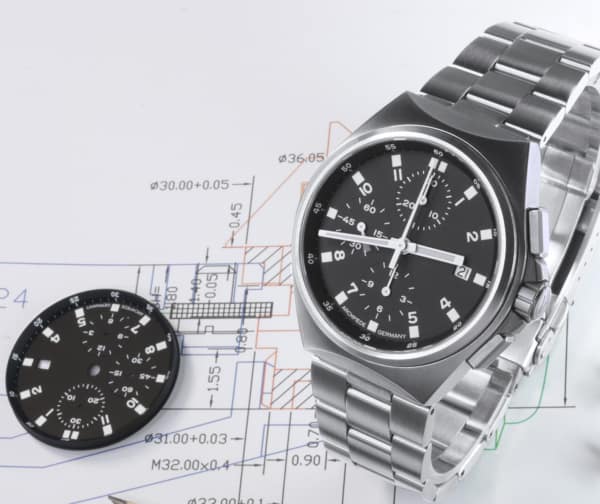“Our life is frittered away by detail. Simplify, simplify.” So said Thoreau. The sentiment applies equally well to watchmakers as writers. But designing and making a simple watch is actually very difficult indeed. It’s partly because simplicity gives nowhere to hide mistakes or failings of proportion (“Ew – why are those hands *that* shape?”). It’s also because every single visual point matters, from the angle of the indices to the profile of the case. Step one way and you get naff all over your shoes, step the other and you get desiccated by austerity. Simple ain’t easy.
Introducing the Archimede 1950-3, A Proper Take On Simple
That said, Pforzheim-based watchmaker Archimede’s new 1950-3 watches are a fine example of how to do it. If you’re after bling, busy dials, fuss and flounce, these are not the watches for you. Instead, you get a case, an almost plain dial, a crystal, a strap and a matching pair of hands. That’s it. Everything works in harmony, but think Bach rather than Prokofiev.
Choosing your 1950-3 needs only two decisions: which dial and which strap. Archimede are offering a matte lapaz blue or a matte black dial. Both curve down at their edges where they meet the rehaut, echoing the domed sapphire (with a plexi option) crystal. And apart from a closed minute track – shades of old 1016 gilt-dial Explorers – the only features are the two words “Archimede” and “Germany” either side of the 6. The three leather straps come in black, dark brown and light brown, all with contrasting stitching and an optional deployant clasp if you fancy zhuzhing it up a bit.
Back to those dials. Where some watches can have you peering at a mess of numbers and wondering what the hell the time is, it’s hard to see how this one could be any clearer. You don’t even get the distraction of a second hand. That might annoy some people, but there’s always the 1950-1 or 2 instead if you want a bit more dialside excitement.
Archimede could have opted for a conventional green luminous paint for the five minute markers and (of course) sans-serif numerals, which would have made the dial look like Fred Astaire in Reeboks. Instead, they stuck with the design and chose a shade that’s reminiscent of aged tritium. The plain, pointed, stick hands use the same gentle lume and are equally unfussy but have just the right proportions to be legible at a glance.

The case continues the theme of being unshowy but well thought-out. It’s apparently plain enough; 316L stainless, 40mm diameter, just under 10mm thick, 3 atm screw-down sapphire display back. Nothing that stands out or draws the eye particularly. But it’s when you start thinking about the choices that the watchmaker made you realize how they got it just right.
Make the whole case polished and it would be just a bit too shiny – like mirror-buffing an IWC Mk X. Make it brushed and it would be just a bit too modern to carry the dial design. Instead, Archimede have opted to brush the case sides and polish the bezel. That takes some of the visual weight away from the solid dial and stops it looking too flat, despite the matte finish.
The caseback has a sapphire insert and the caseback edge is laser engraved (quite something to watch as the caseback is mounted in a brass case holder as the laser circles it, cutting each letter individually). You can choose your own engraving too, at extra cost.
It’s perhaps not surprising that Archimede have access to a decent case – they’re owned by casemaking firm Ickler. Karl Ickler (Archimedes’ current owner’s great grandfather and father respectively) founded the business in 1924. As co-owner Lisa Ickler explains, “My great grandfather rebuilt the company, which had lain dormant during the war. Today my father Thomas and I are running it.”
You’ll have seen Ickler cases housing movements from some very well known watchmakers, although the firm is appropriately discrete about which ones. And Ickler does everything in house – design, construction, prototyping, parts, production as well as surface finishing and treatment.
You also have a choice of engines. You can opt for an automatic Sellita SW 200-1 (no fussing about giving a solid and reliable stock movement a daft in-house name) or upgrade to a hand-winding Sellita SW215 for just over $70. Fitting the rest of the watch, the movement is undecorated and left to do its job without being shouty.
With some watches, it’s easy to pick on one thing that makes them interesting. For some it’s the movement that saves a perhaps otherwise uninteresting design. For others, a stock motor powers a well-designed dial and hand set-up. With the 1950-3, everything works together from the case in. Each element of the watch goes to make up the whole – take anything away or change it too much and it would either get fussy or become austere. Archimede have pulled off that rare trick – they’ve actually made a simple watch beautifully. More from Archimede.
Header photo by: Tor-Helge Gilleshammer / @watch.gilles









 Featured Videos
Featured Videos













